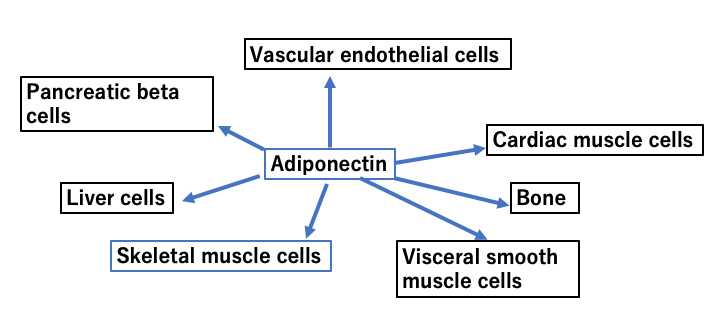
Diabetes, Insulin, and Adiponectin
Everybody may know insulin, our essential hormone required to regulate glucose level in our blood. Decrease of insulin causes serious disease, diabetes mellitus. More than 20 million Japanese people including people who have a potential-risk to suffer the disease are exposed to the physical troubles caused by this disease. One hundred years ago US researchers, Banting and Best, found insulin. By the way, November 14th is the World Diabetes Mellitus Day proposed by United Nations. Since the symbol color of this day is blue, at many places in the world blue light is lit like that at Kobe marine museum (Top picture and Fig. 2 ). Why is the United Nations concerned about diabetes? It is because the increase of diabetes patients in the world causes a tremendous increase of total cost for healthcare. Obesity defined as BMI>=25 is about 20 % of total Japanese population which is lower compared to US, Mexico (about 70%) and UK (about 60%) according to OECD statistics in 2020. However, people in the area of east Asia suffer from diabetes more frequently because their insulin secretion level is lower than that of people in the western world. Prof. Kadowaki’s group of Tokyo Univ. School of Medicine studied differences in terms of genes related to the levels of insulin secretion between Japanese and people in western countries and found several candidate genes contributing to the difference.


Although Awaji Island is a kind of premier place in terms of healthy life as described in this homepage, there is an unavoidable health issue based on a lack of public transportation systems. In Awaji Island people have to use their own car for their daily life, they use less time for physical exercise, leading to risky situation for diabetes and lifestyle dependent syndromes as well. The lifestyle dependent syndromes are diabetes mellitus, hyperlipidemia, and hypertension which are depending on your lifestyle like, foods, daily physical exercise, sleep, etc. A serious case of these syndromes leads to death because of like cerebral infarction and/or myocardial infarction.
In case of diabetes, your blood glucose level is kept at more than 100 mg/dl. This high level of blood glucose induces increase of water level in blood causing high blood pressure and increase active oxygen as well. This toxic oxygen negatively affects blood vessels, leading to a brake of capillary blood vessels in brain, kidney and/or eyes, causing cerebral apoplexy, uremia, and/or blindness、respectively.
Excess level of glucose is brought about by overeating foods including sugars and lipids more than what is needed to maintain your energy level. It is also the case when lacking physical exercise because of work or other reasons, leading to less consumption of energy. These suggest that adequate diet and appropriate exercise are required to keep you in a good shape. However, it is difficult to do these any places in the world, it enhances the risk of life-style dependent syndromes.
After meals, starch in rice and bread is digested by the enzymes like amylase from saliva and intestines. Glucoses thus made is taken up at small intestines and go around our body through blood as our energy source. Excess levels of glucose in our blood after consumption, like in skeletal muscle, are taken up by a glucose transporter in liver cells and stored there as glycogen by using insulin. Glycogen is digested to glucose when more energy is needed under the control of adrenalin, another important hormone for our life. Excess level of glucose is also stored as lipid in adipose cells. Adipose cells form adipose tissues and attach to visceral organs as fat. To take up glucose from blood to liver or other organ cells like skeletal muscle, insulin is needed. As described above without insulin or decrease of insulin level cause diabetes. Diabetes are classified into two independent types. Type I diabetes is caused by insufficient insulin caused by malfunction of the pancreas where less insulin is produced based on an inherited defect of pancreas and/or self-immune defect. Type II is based on your lifestyle. For example, obesity causes to produce more adipose cells to store excess energy as lipids.
Here we would like to introduce an important scientific finding made by Prof. Matsuzawa’s group of Osaka Univ. in 1996. (A. Arita, Y. Matsuzawa, et al. Paradoxical decrease of adipose-specific protein, adiponectin (1996) BBRC, 257, 79-83). That is a new hormone named “adiponectin” required for maintaining a good level of blood glucose and avoid cerebral infarction etc., related to circulatory diseases.
Adiponectin is released from adipose cells, circulates in blood and binds to a receptor protein of vascular endothelial cells, cardiac muscle cells, skeletal muscle cells, visceral smooth muscle cells, liver cells, and bone cells. Accordingly, this hormone affects metabolic reactions within these cells. Mostly it affects signal transmission pathways in the cells while the pathways are quite diverse depending on the cell types. Quite diverse effects of this hormone are summarized in the recent review article (B. Roy and S. Planiyandi, Tissue specific role and associated downstream signaling pathways of adiponectin, Cell Biosci.(2021) 11:77) Here we would like to introduce a part of this article related to correlation of the hormone with diabetes and arteriosclerosis.

As described above, after over-eating, glucose and lipids increase in your blood. Under such situation, lipids including cholesterols and neutral lipids accumulate and damage the vascular endothelium of blood vessels. Macrophage cells come to this area to eat the lipids and make plaques. Consequently, the blood stream becomes not smooth and then the accumulated macrophages secrete cytokines, leading to inflammation. This is a typical arteriosclerosis. After extended inflammation, a crust is formed and then degraded crust is released from the inflammation site to blood and circulate the whole body. Some of them cause congestion of the blood stream especially in capillary blood vessels in the brain, heart and lungs, leading to brain, heart or lung infarction. Adiponectin prevent the arteriosclerosis, resulting in decrease of the risk of brain and cardio infarction. This hormone also enhances acidification of fatty acids and consumption of fat, secretion of insulin from pancreas, uptake of glucose from blood to liver and/or skeletal muscle. These phenomena consequently prevent obesity. On the other hand, under the obesity condition, adipose cells cause programed cell death (apoptosis) by over-accumulation of lipids. This causes a decrease of adiponectin secretion. Under normal body weight conditions, adiponectin is secreted from the adipose cells. Some of the green and red vegetables are believed to increase the level of adiponectin. But it needs further study because it is not necessarily clear whether or not it is effective scientifically.
As described above, avoiding overeating and appropriate exercises prevent the life-style dependent syndromes. It is believed that a 20 minutes quick walk, twice a week is good enough for this. Less sugars and lipids are good to keep your body weight in good condition (suitable weight for you=height in meter x height in meter x 22). The author of book “keep your waist girth less than 85 cm” (in Japanese, Gentosha (2018) ), Dr. Masako Okuda, tells us that waist girth has to be less than 85 cm and 90 cm for men and women respectively, since Japanese easily get offal fat, leading to diabetes.
